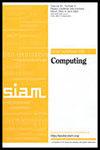Fixed-Parameter Algorithms for the Kneser and Schrijver Problems
IF 1.6
3区 计算机科学
Q3 COMPUTER SCIENCE, THEORY & METHODS
引用次数: 0
Abstract
SIAM Journal on Computing, Volume 53, Issue 2, Page 287-314, April 2024.Abstract. The Kneser graph [math] is defined for integers [math] and [math] with [math] as the graph whose vertices are all the [math]-subsets of [math] where two such sets are adjacent if they are disjoint. The Schrijver graph [math] is defined as the subgraph of [math] induced by the collection of all [math]-subsets of [math] that do not include two consecutive elements modulo [math]. It is known that the chromatic number of both [math] and [math] is [math]. In the computational Kneser and Schrijver problems, we are given access to a coloring with [math] colors of the vertices of [math] and [math], respectively, and the goal is to find a monochromatic edge. We prove that the problems admit randomized algorithms with running time [math], hence they are fixed-parameter tractable with respect to the parameter [math]. The analysis involves structural results on intersecting families and on induced subgraphs of Kneser and Schrijver graphs. We also study the Agreeable-Set problem of assigning a small subset of a set of [math] items to a group of [math] agents, so that all agents value the subset at least as much as its complement. As an application of our algorithm for the Kneser problem, we obtain a randomized polynomial-time algorithm for the Agreeable-Set problem for instances with [math]. We further show that the Agreeable-Set problem is at least as hard as a variant of the Kneser problem with extended access to the input coloring.
克奈瑟和施里弗问题的固定参数算法
SIAM 计算期刊》,第 53 卷第 2 期,第 287-314 页,2024 年 4 月。 摘要。Kneser图[math]是为整数[math]和[math]定义的,其中[math]是其顶点是[math]的所有[math]子集的图,如果两个这样的集不相交,它们就是相邻的。Schrijver图[math]被定义为[math]的子图,由[math]的所有不包含两个连续元素的[math]子集的集合所引起。已知[math]和[math]的色度数都是[math]。在计算 Kneser 和 Schrijver 问题中,我们分别得到了[math] 和[math] 顶点的[math]色着色,目标是找到一条单色边。我们证明,这些问题可以用运行时间为[math]的随机算法解决,因此它们在参数[math]方面是固定参数可控的。分析涉及相交族以及 Kneser 和 Schrijver 图的诱导子图的结构性结果。我们还研究了将[数学]项集合的一个小子集分配给一组[数学]代理的 "可协商集合 "问题,从而使所有代理对该子集的重视程度至少与其补集相同。作为我们对 Kneser 问题算法的一个应用,我们得到了一个针对 [math] 实例的 Agreeable-Set 问题的随机多项式时间算法。我们进一步证明,Agreeable-Set 问题的难度至少与扩展了输入着色访问权限的 Kneser 问题的变种相当。
本文章由计算机程序翻译,如有差异,请以英文原文为准。
求助全文
约1分钟内获得全文
求助全文
来源期刊

SIAM Journal on Computing
工程技术-计算机:理论方法
CiteScore
4.60
自引率
0.00%
发文量
68
审稿时长
6-12 weeks
期刊介绍:
The SIAM Journal on Computing aims to provide coverage of the most significant work going on in the mathematical and formal aspects of computer science and nonnumerical computing. Submissions must be clearly written and make a significant technical contribution. Topics include but are not limited to analysis and design of algorithms, algorithmic game theory, data structures, computational complexity, computational algebra, computational aspects of combinatorics and graph theory, computational biology, computational geometry, computational robotics, the mathematical aspects of programming languages, artificial intelligence, computational learning, databases, information retrieval, cryptography, networks, distributed computing, parallel algorithms, and computer architecture.
 求助内容:
求助内容: 应助结果提醒方式:
应助结果提醒方式:


